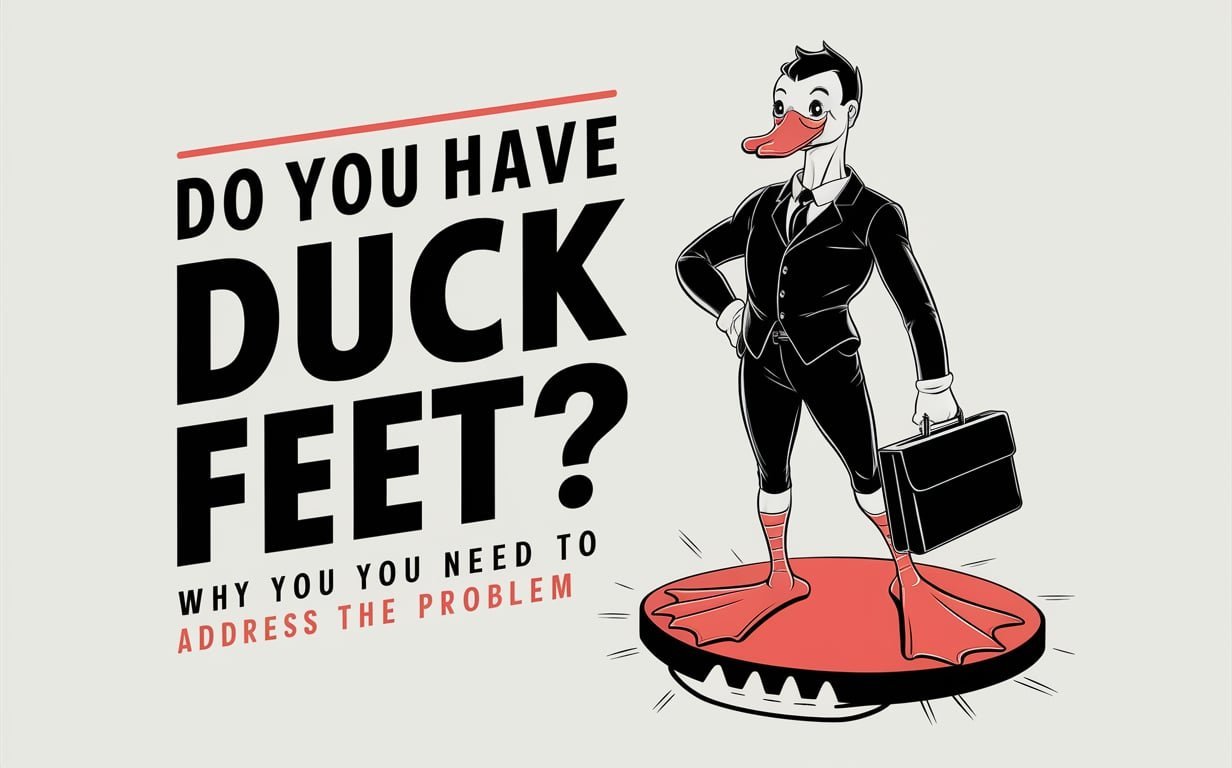Do You Have Duck Feet? Why You Need to Address the Problem

Having “duck feet” is a common cause of foot problems that many people deal with but often try to ignore. Duck feet, also known as pronated feet, occur when the arches in the feet collapse inward instead of maintaining their normal arched shape. This causes the feet to roll inward excessively when walking or standing. About 30% of the population has moderate to severe pronated feet. If left unaddressed, duck feet can lead to ankle, knee, hip, and even back problems due to the stresses and strains placed on the body.
Anatomy of Duck Feet
To understand duck feet, it’s important to first understand normal foot anatomy. A healthy foot has a strong arch that supports the body’s weight and distributes it evenly across the foot. The arch comprises the tarsal bones in the midfoot and provides shock absorption and stability during activities like walking and running.
When you have duck feet, the posterior tibial tendon and other small muscles and ligaments in the foot become weak or stretched out. This causes the arches to collapse inward, resulting in overpronation. As the foot rolls inward excessively with each step, the ankle is also forced to roll inward. This changes the normal gait pattern and body mechanics.
Some key signs that you may have duck feet include:
- Flat feet or low arches visible when standing or looking at the bottom of your feet
- Heel inward rolling or “rolling over” of the ankle
- Inward rolling motion is seen from the back when walking or running
- Possible soreness or pain on the inside of the ankle or arch
In severe cases, the altered biomechanics may aggravate the calves, knees, hips, and lower back. Over time, duck feet can even contribute to ankle sprains if the inward rolling causes instability. Addressing abnormal pronation early is important for long-term foot, ankle, and body health.
Causes of Duck Feet
There are a few different reasons why someone may develop pronated feet or “duck feet”:
Genetics
Some familial traits make certain individuals prone to weaker foot muscles and ligaments that cannot support the arch well. Heredity plays a role in about 50-75% of cases. If a parent has overpronating feet, their children are also more likely to have the condition.
Developmental Issues
Issues during infancy, like not crawling or walking at appropriate ages, can prematurely weaken the foot muscles. Likewise, congenital anomalies in foot structure present from birth may predispose the feet to collapse inward. Things like clubfoot or overly mobile flat feet must be addressed early.
Overuse Injuries
Repetitive stress from high-impact activities like running in improper shoes can overstretch the plantar fascia ligaments and weaken the arch over time. Sports involving a lot of cutting, jumping, and lateral movements exacerbate the problem for predisposed people.
Body Weight Changes
Gaining significant weight often places too much strain on the feet, especially for someone with weak arches. Extra pounds must be supported and force the feet into further pronation. Losing weight can help in mild to moderate cases.
The causes vary, but duck feet frequently have genetic and lifestyle influences that stress the foot’s structure beyond its natural capability to maintain a stable arch position.
Effects of Duck Feet
If left unaddressed, pronated or “duck feet” can lead to a host of problems higher in the body. Some common effects of overpronation include:
Plantar Fasciitis
The ligament running across the bottom of the foot becomes inflamed due to the increased stretching from foot rolling. Plantar fasciitis results in sharp heel pain, especially with initial steps after rest.
Shin Splints
The abnormal gait forces the shins to compensate in strange ways, causing microtears in the muscles and inflammation along the shinbone.
Knee Pain
The knees track incorrectly due to unstable foot positioning, often resulting in issues like the runner’s knee, IT band syndrome, or cartilage damage over time.
Lower Back Pain
The hips and pelvis adjust to the unstable foundation below, placing undue strain on the back muscles and joints to maintain proper posture and balance.
Ankle Sprains
With each step, the ankle rolls too far inward, creating instability and vulnerability to inversion or “rolling over” ankle sprains, especially on uneven surfaces.
Bunions and Foot Deformities
Long-term excessive foot motion can alter the foot’s structure, causing bunions, hammertoes and other misalignments as an indirect consequence of overpronation.
Addressing duck feet is crucial before these secondary problems develop or worsen due to the altered foot biomechanics pronation. Early treatment saves future issues and long-term discomfort.
Diagnosing Duck Feet
If you suspect you have pronated feet, the first step is to see a podiatrist, orthopedist, or other foot specialist for evaluation. A few simple tests can help diagnose and assess the degree of overpronation:
Wet Foot Test
The podiatrist observes the outline of your wet foot on paper. An arched print indicates normal feet, while a footprint resembling blobs suggests the arch’s collapse.
Inversion/Eversion Test
While sitting, the doctor manually moves your ankle inward and outward to check mobility and note any asymmetry or excessive motions, which are signs of lax ligaments.
Single Leg Raise
Lying down, the physician watches how the leg and foot position changes when lifting one leg at a time. Pronation is seen as inward rolling of the ankle and leg positioning.
Achilles Tendon Alignment
With bare feet placed together, the doctor checks from behind to see if the Achilles tendons are aligned straight or if one leg pronates more, bringing the tendon out of line.
X-rays may also be taken to examine the foot bone structure and ensure there are no underlying issues causing pronation. The practitioner will diagnose the level of pronation based on the physical exam findings.
Treatment of Duck Feet
Once diagnosed, a few effective treatment methods are routinely used to address overpronation:
Orthotics
Custom-made arch supports or orthotics are commonly prescribed to control excessive pronation. Fitted by a podiatrist, the rigid orthotics fit inside shoes to provide stability and keep the feet from rolling in. Over-the-counter inserts are usually not supportive enough for moderate to severe cases.
Strengthening Exercises
Targeted exercises like towel crunches, heel raises, and toe curls at home help build the small intrinsic foot muscles over time. A physical therapist can design a customized routine and also perform manual therapy techniques to elongate tight leg muscles that contribute to overpronation.
Proper Footwear
Motion control shoes with stability features and firm arch support are important. Neutral or cushioned shoes only allow more excessive foot rolling. Replace shoes regularly as the support breaks down over time and miles.
Splints or Taping
For acute cases, a splint worn at night or kinesiology taping applied during the day restricts abnormal foot positions to allow healing. This supports the ligaments and tendons until the muscles are stronger.
Injection Therapies
Cortisone injections can relieve inflammation around the Achilles tendon or plantar fascia in refractory cases unresponsive to conservative therapy. PRP injections use the patient’s own growth factors to promote the healing of injured structures.



Leave a Reply